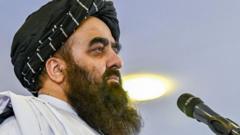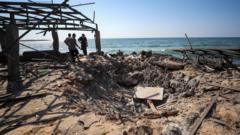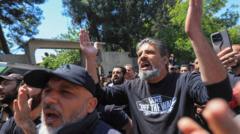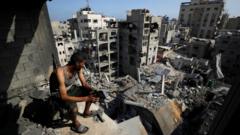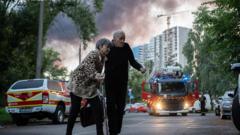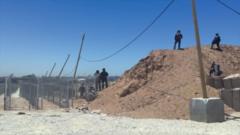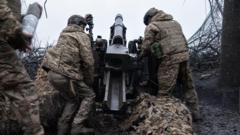Ukrainian soldiers in the Sumy region face nightly drone assaults from Russia, employing World War One-era weapons to combat the advanced Shahed drones. Amidst the chaos, personal stories of loss and resilience emerge, reflecting the long-term impact of the ongoing war.
The Relentless Drone Battle: Ukrainian Soldiers on the Frontlines
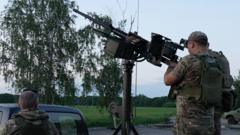
The Relentless Drone Battle: Ukrainian Soldiers on the Frontlines
As Russia intensifies drone attacks on Sumy, Ukrainian troops confront the challenges of outdated weaponry against modern warfare.
In the northeastern region of Sumy, Ukraine, soldiers engage in a relentless, nightly battle against a swarm of drones launched by Russia. Just as dusk fell, Ukrainian troops stepped out from the treeline prepared to intercept around 100 Iranian-designed Shahed drones, a significant component of Russia's aerial warfare strategy. They are armed with heavy machine guns designed in an era long before the technological advancements of today.
The atmosphere is thick with tension as Commander “Jaeger” monitors a screen full of red dots representing incoming threats. On this particular evening, 30 drones were already crowded in the sky above Sumy and nearby Chernihiv. Troops, flanked by their vehicles transformed into makeshift gun platforms, prepared themselves as the whir of propellers signaled the arrival of an aerial enemy.
Despite their best efforts, the sighting of a drone often precedes an unsuccessful attempt to shoot it down. As weapons fire erupted futilely into the night air, Jaeger emphasized the emotional toll of these encounters. “You feel a slight sadness," he admitted, "but you don’t have time for emotions." Dealing with relentless waves of drones trained to wreak havoc, these men did not afford themselves the luxury of despair.
Jaeger is part of a "mobile fire unit" boasting a mixed bag of locals, including a farmer now focused on battlefield defense and a builder redirecting his skills. Their camaraderie is laced with humor, even in their dire circumstances. "It's just like Groundhog Day," Jaeger remarked about the repetitive nature of their nightly rituals.
The Sahed drones are not only a threat to military defenses but are also directed towards urban centers, including the Ukrainian capital, Kyiv. An air raid alert frequently interrupts the night, signaling the ominous intentions behind the drones’ passage, as evidence of the attack’s toll began to surface in the form of civilian casualties.
Margaryta Husakova, a survivor of one such drone strike that decimated a civilian bus, poignantly recounted her experiences. Her story reflects the personal anguish mirrored across countless families in war-torn Ukraine. In an emotional account, she described the horrifying aftermath of the incident that claimed the lives of her mother, sister, and uncle.
The ruinous impact of the ongoing conflict is palpable, as the landscape of Ukraine shifts from fertile fields to frontline battlegrounds laden with the remnants of war. As the conflict enters its fourth summer, the soldiers and citizens alike ponder the length and unresolved nature of the war.
With the looming threat of further escalations, including President Putin's aspirations for territorial gains, the despair for peace seems far-reaching. The grim reality is that time is both a motivator and an enemy for those defending their homeland, with soldiers expressing doubt about the imminent cessation of hostilities and the psychological scars each encounter leaves behind.
As fresh reinforcements prepare for combat, their stories reflect not only the challenges on the battlefield but also the emotional struggles endured by those fighting and the families left behind. The future remains uncertain, but for these soldiers, the battle continues, marked by the sorrow and the unwavering resilience that comes with their commitment.


